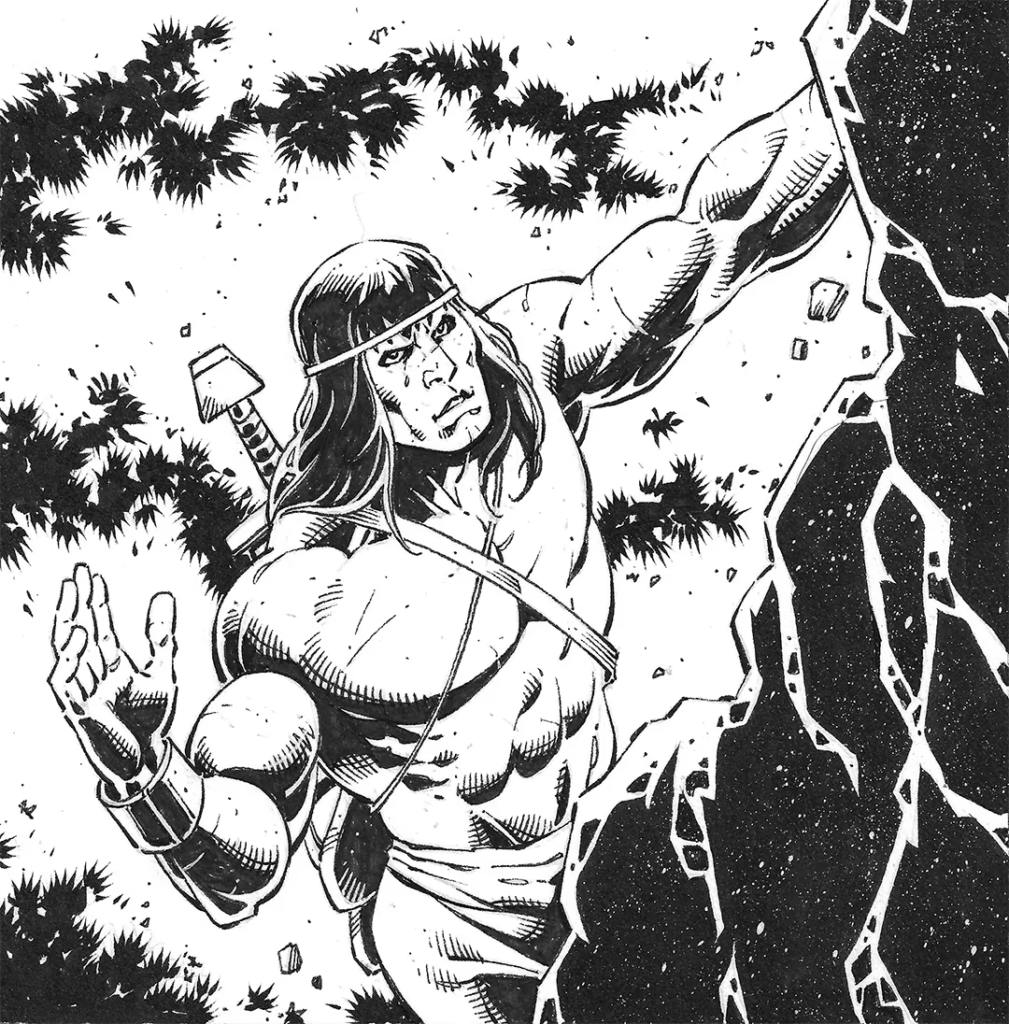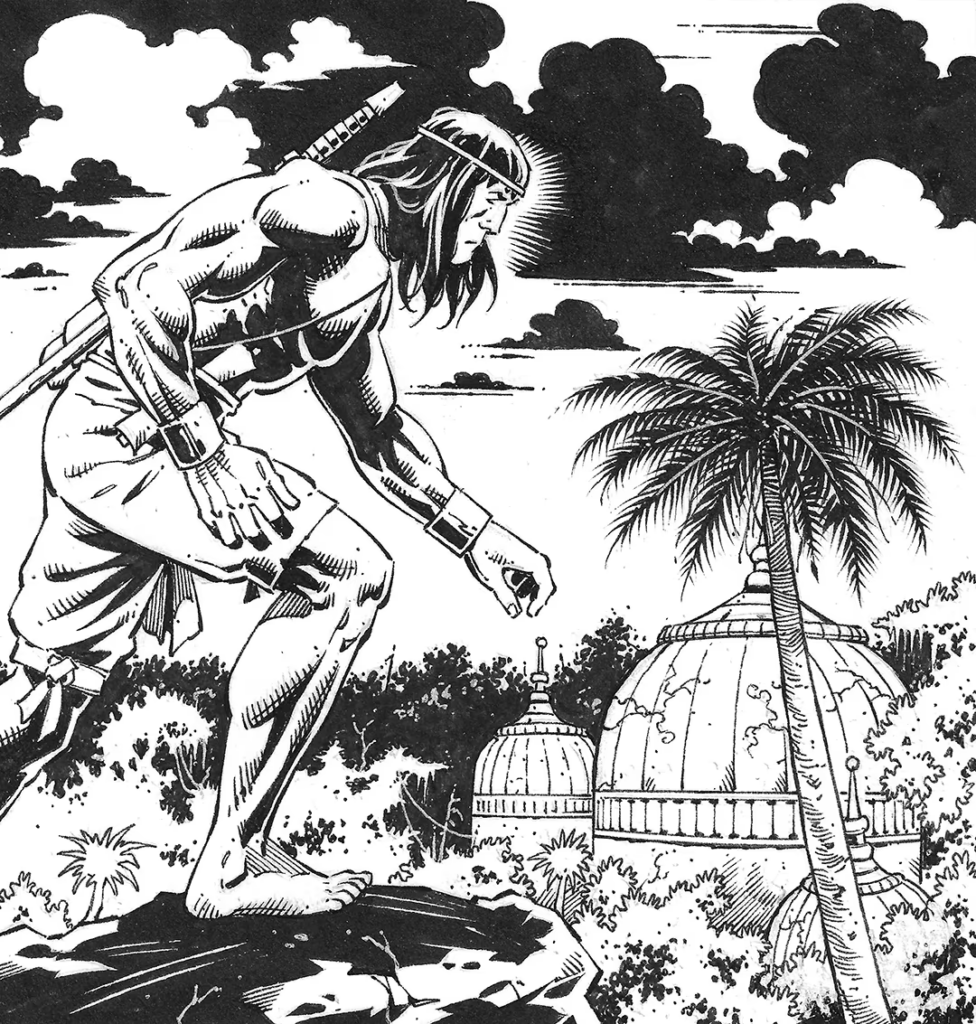Arkhaven Spotlight: Conan – The Jewels of Gwahlur

Welcome to the Arktoons Spotlight, a regular feature at the Arkhaven Blog. The Spotlight is where I take a look at one title from the amazing world of Arkhaven’s webtoons.
If you aren’t familiar with Arktoons, this is meant for you. I am the Dark Herald; I do the blogging here at Arkhaven.com. The blog is mostly pop culture news, reviews, and opinion, in short, the usual.
And you aren’t here for the blog. You’re here for the webtoons.
Arkhaven is different from other webtoons publishers. While we have the kind of webtoons you would expect, like Chateau Grief we also have works that are more like traditional comics, if you grew up reading comic books in pamphlet format, you’ll feel more at home here than you would at say Tapas.io or Webtoons.com.
So, if you are new here, be welcome.
What is the difference between the fantasy genres of High Fantasy versus Sword and Sorcery?
A question that any fantasy writer is going to have to face sooner or later. In simplest possible terms, High Fantasy stories concern the lives and adventures of kings and princesses. The great and the powerful. Sword and Sorcery stories are about thieves and whores. There is of course some crossover between high and low born in each genre but that is basically it.
There are some other tropes that are other tropes that are easy identifiers. In High Fantasy magic can be good or evil depending.
Whereas in Sword and Sorcery , magic is usually pretty bad news and it’s certainly dangerous as all hell even if it isn’t. Sword and Sorcery doesn’t have to be dark and gritty but it does have to be gritty.
High Fantasy is The Lord of the Rings. Sword and Sorcery is the adventures of Aragorn in a world where Sauron has won the War of the Ring.
When considering the setting of a story there are two authors that must be consciously either accepted or rejected. If you are writing High Fantasy, the author in question is J.R.R. Tolkien. If you are penning a tale of Sword and Sorcery then you have to carefully consider the works of Robert Howard.
Which was difficult to do for quite a while when I was young. It was extremely difficult to find anything that wasn’t pastiche of Robert Howard. What you would end up comparing yourself to were the works of L. Sprague De Camp, a man who clearly resented the fact that his most famous work, Lest Darkness Fall, was largely forgotten when compared to the Conan pastiche he wrote.
It wasn’t until the 1990s that the real works of Robert Howard started finding his way out of the shadows again. There is really no comparing the two and in his deepest heart De Camp knew it.
Take a look at the real thing yourself.

Paths of Intrigue
The cliffs rose sheer from the jungle, towering ramparts of stone that glinted jade-blue and dull crimson in the rising sun, and curved away and away to east and west above the waving emerald ocean of fronds and leaves. It looked insurmountable, that giant palisade with its sheer curtains of solid rock in which bits of quartz winked dazzlingly in the sunlight. But the man who was working his tedious way upward was already halfway to the top.
He came of a race of hillmen, accustomed to scaling forbidding crags, and he was a man of unusual strength and agility. His only garment was a pair of short red silk breeks, and his sandals were slung to his back, out of his way, as were his sword and dagger.
The man was powerfully built, supple as a panther. His skin was bronzed by the sun, his square-cut black mane confined by a silver band about his temples. His iron muscles, quick eyes and sure feet served him well here, for it was a climb to test these qualities to the utmost. A hundred and fifty feet below him waved the jungle. An equal distance above him the rim of the cliffs was etched against the morning sky.
He labored like one driven by the necessity of haste; yet he was forced to move at a snail’s pace, clinging like a fly on a wall. His groping hands and feet found niches and knobs, precarious holds at best, and sometimes he virtually hung by his finger nails. Yet upward he went, clawing, squirming, fighting for every foot. At times he paused to rest his aching muscles, and, shaking the sweat out of his eyes, twisted his head to stare searchingly out over the jungle, combing the green expanse for any trace of human life or motion.
Now the summit was not far above him, and he observed, only a few feet above his head, a break in the sheer stone of the cliff. An instant later he had reached it—a small cavern, just below the edge of the rim. As his head rose above the lip of its floor, he grunted. He clung there, his elbows hooked over the lip. The cave was so tiny that it was little more than a niche cut in the stone, but held an occupant.
A shriveled mummy, cross-legged, arms folded on the withered breast upon which the shrunken head was sunk, sat in the little cavern. The limbs were bound in place with rawhide thongs which had become mere rotted wisps. If the form had ever been clothed, the ravages of time had long ago reduced the garments to dust. But thrust between the crossed arms and the shrunken breast there was a roll of parchment, yellowed with age to the color of old ivory.

The climber stretched forth a long arm and wrenched away this cylinder. Without investigation he thrust it into his girdle and hauled himself up until he was standing in the opening of the niche. A spring upward and he caught the rim of the cliffs and pulled himself up and over almost with the same motion.
There he halted, panting, and stared downward.
It was like looking into the interior of a vast bowl, rimmed by a circular stone wall. The floor of the bowl was covered with trees and denser vegetation, though nowhere did the growth duplicate the jungle denseness of the outer forest. The cliffs marched around it without a break and of uniform height. It was a freak of nature, not to be paralleled, perhaps, in the whole world: a vast natural amphitheater, a circular bit of forested plain, three or four miles in diameter, cut off from the rest of the world, and confined within the ring of those palisaded cliffs.
But the man on the cliffs did not devote his thoughts to marveling at the topographical phenomenon. With tense eagerness he searched the tree-tops below him, and exhaled a gusty sigh when he caught the glint of marble domes amidst the twinkling green. It was no myth, then; below him lay the fabulous and deserted palace of Alkmeenon.

Conan the Cimmerian, late of the Baracha Isles, of the Black Coast, and of many other climes where life ran wild, had come to the kingdom of Keshan following the lure of a fabled treasure that outshone the hoard of the Turanian kings.
Jewels of Gwahlur — The illustrated edition of the public domain story about Conan the Cimmerian, THE JEWELS OF GWAHLUR by Robert E. Howard. Illustrated by Richard Bonk.
If you enjoy this or indeed any of our Arktoons, please consider our creators.

